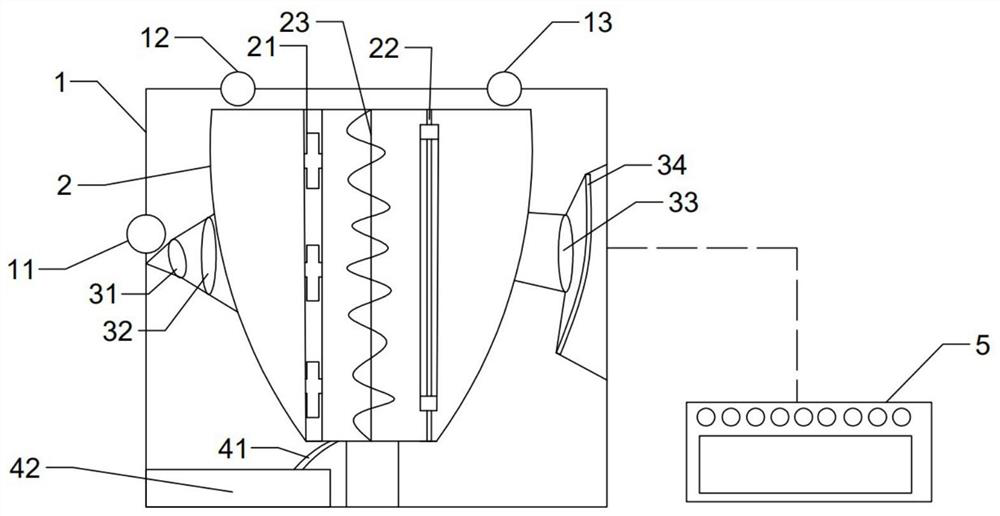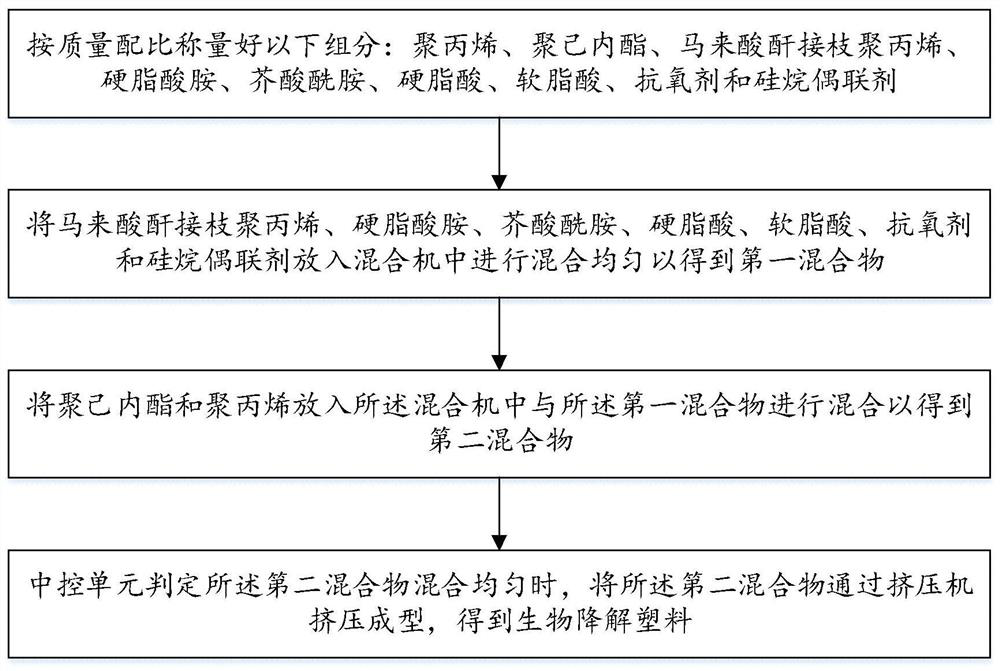A way to speed up the biodegradation of plastics
A biodegradation and plastic technology, applied in the field of accelerating plastic biodegradation, can solve the problem of accelerating plastic biodegradation without the number of particles
- Summary
- Abstract
- Description
- Claims
- Application Information
AI Technical Summary
Problems solved by technology
Method used
Image
Examples
Embodiment 1
[0142] Step 1, weigh the following components according to the mass ratio: 30 parts of polypropylene, 20 parts of polycaprolactone, 2 parts of maleic anhydride grafted polypropylene, 10 parts of stearic acid amine, 5 parts of erucamide, hard 0.5 part of fatty acid, 0.5 part of palmitic acid, 0.5 part of antioxidant and 0.5 part of silane coupling agent;
[0143] Step 2, put maleic anhydride grafted polypropylene, stearic acid amine, erucic acid amide, stearic acid, palmitic acid, antioxidant and silane coupling agent into mixer 1 and mix uniformly to obtain the first mixture;
[0144] Step 3, putting polycaprolactone and polypropylene into the mixer 1 and mixing with the first mixture to obtain a second mixture;
[0145] Step 4, when the central control unit 5 determines that the second mixture is mixed uniformly, the second mixture is extruded by an extruder to obtain a biodegradable plastic.
Embodiment 2
[0147] Step 1, weigh the following components according to the mass ratio: 50 parts of polypropylene, 30 parts of polycaprolactone, 5 parts of maleic anhydride grafted polypropylene, 15 parts of stearic acid amine, 10 parts of erucamide, hard 3 parts of fatty acid, 3 parts of palmitic acid, 3 parts of antioxidant, 3 parts of silane coupling agent;
[0148] Step 2, put maleic anhydride grafted polypropylene, stearic acid amine, erucic acid amide, stearic acid, palmitic acid, antioxidant and silane coupling agent into mixer 1 and mix uniformly to obtain the first mixture;
[0149] Step 3, putting polycaprolactone and polypropylene into the mixer 1 and mixing with the first mixture to obtain a second mixture;
[0150] Step 4, when the central control unit 5 determines that the second mixture is mixed uniformly, the second mixture is extruded by an extruder to obtain a biodegradable plastic.
Embodiment 3
[0152] Step 1, weigh the following components according to the mass ratio: 40 parts of polypropylene, 25 parts of polycaprolactone, 3 parts of maleic anhydride grafted polypropylene, 12 parts of stearic acid amine, 7.5 parts of erucamide, hard 2 parts of fatty acid, 2 parts of palmitic acid, 1.5 parts of antioxidant, 1.5 parts of silane coupling agent;
[0153] Step 2, put maleic anhydride grafted polypropylene, stearic acid amine, erucic acid amide, stearic acid, palmitic acid, antioxidant and silane coupling agent into mixer 1 and mix uniformly to obtain the first mixture;
[0154] Step 3, putting polycaprolactone and polypropylene into the mixer 1 and mixing with the first mixture to obtain a second mixture;
[0155] Step 4, when the central control unit 5 determines that the second mixture is mixed uniformly, the second mixture is extruded by an extruder to obtain a biodegradable plastic.
PUM
 Login to View More
Login to View More Abstract
Description
Claims
Application Information
 Login to View More
Login to View More - R&D
- Intellectual Property
- Life Sciences
- Materials
- Tech Scout
- Unparalleled Data Quality
- Higher Quality Content
- 60% Fewer Hallucinations
Browse by: Latest US Patents, China's latest patents, Technical Efficacy Thesaurus, Application Domain, Technology Topic, Popular Technical Reports.
© 2025 PatSnap. All rights reserved.Legal|Privacy policy|Modern Slavery Act Transparency Statement|Sitemap|About US| Contact US: help@patsnap.com


